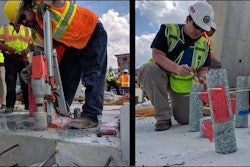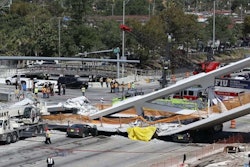A first-of-its kind Miami pedestrian bridge that collapsed Thursday, killing at least six people, was being built with Accelerated Bridge Construction (ABC) methods, and stress tests were underway when it failed, officials say.
A contractor’s crews were conducting the stress tests on the incomplete structure at the time of the collapse, according to Miami-Dade Mayor Carlos Gimenez.
And in a tweet Thursday evening, Florida Senator Mark Rubio said cables were being tightened when the main span failed. He wrote that “the cables that suspend the #Miami bridge had loosened & the engineering firm ordered that they be tightened. They were tightened when it collapsed today.”
The 174-foot span of the concrete bridge at Florida International University weighed 950 tons, and it crashed down onto cars waiting at a stop light about 1:30 p.m.
The ABC methods that were being used are intended to make bridge building easier and minimize disruptions. ABC, used increasingly throughout the nation, involves constructing some parts off-site and then moving them to the site and hoisting them into place. In the Miami bridge failure, the pieces were assembled on the roadside and then put into place Saturday morning.
“We are stunned by today’s tragic collapse of a pedestrian bridge that was under construction over Southwest Eighth Street in Miami,” says a statement provided to Equipment World by FIGG Bridge Engineers, the engineering firm on the project.
“Our deepest sympathies are with all those affected by this accident. We will fully cooperate with every appropriate authority in reviewing what happened and why. In our 40-year history, nothing like this has ever happened before. Our entire team mourns the loss of life and injuries associated with this devastating tragedy, and our prayers go out to all involved,” says FIGG, based in Tallahassee, Florida, and known for its artful bridge designs.
By today, the National Transportation Safety Board had dispatched a team of at least 15 investigators to the site to begin probing concrete, steel and other materials, along with the work under way at the time of the collapse. First responders, engineers and other investigators also were on the scene, sifting through rubble. First responders expect to recover more victims from cars that have been crushed beneath the fallen concrete, published reports say.
Companies involved have prior safety issues
Munilla Construction Management of Ford Lauderdale, Florida, and FIGG Bridge Engineering, of FIGG Bridge Group, were working to together to build the walkway valued at more than $14 million. Both companies have histories of safety violations, records show.
On March 5, Munilla was named in a personal injury lawsuit filed in Miami-Dade County by Jose Perez, who alleges he suffered bones, lost wages and future damages after a makeshift bridge at Fort Lauderdale International Airport broke while he was walking on it, pitching him forward and to the ground. The suit alleges that Munilla Construction Management failed to maintain and examine the bridge so that it would bear the weight of an adult, and that the company allowed it to deterioate.
FIGG Bridge Group had been previously fined after part of a bridge span it was building in Hampton Roads, Virginia, crashed onto railroad tracks below in 2012.
In that collapse of a 90-ton section of the South Norfolk Jordan Bridge over the Elizabeth River between Chesapeake and Portsmouth, four workers suffered minor injuries. The Virginia Department of Labor and Industry fined FIGG $28,000 for a serious violation, but records indicate that fine was reduced.
The company did not properly inspect a girder and had not obtained written consent from its manufacturer before modifying it, according to an article in The Virginian-Pilot.
To see OSHA records involving Munilla Construction, click here. To see OSHA records involving FIGG Bridge Group, click here.
Hailed as a bridge to withstand hurricanes
The FIU project was hailed as a novel construction of a bridge aimed at keeping students safe as they traveled from the university to the small city of Sweetwater. The bridge was supposed to last 100 years and be able to withstand a Category 5 hurricane, officials have said.
“The FIU-Sweetwater UniversityCity Bridge is the largest pedestrian bridge moved via Self-Propelled Modular Transportation in U.S. history,” a recent FIU press release says.
“It is also the first in the world to be constructed entirely of self-cleaning concrete. When exposed to sunlight, the titanium dioxide in the concrete captures pollutants and turns it bright white, reducing maintenance costs.”
Just five days before the collapse, the main span was put into place in a process that took only a few hours.
“The main span of the FIU-Sweetwater UniversityCity Bridge was lifted from its temporary supports, rotated 90 degrees across an eight-lane thoroughfare, and lowered into its permanent position,” an FIU press release says, lauding the accomplishment.
“FIU is about building bridges and student safety. This project accomplishes our mission beautifully,” FIU President Mark B. Rosenberg had said, noting the bridge was installed with minimal disruption to traffic.
“We are filled with pride and satisfaction at seeing this engineering feat come to life and connect our campus to the surrounding community where thousands of our students live.”
ABC is being advanced by a school at FIU
The ABC methods for bridge sections are being advanced at FIU’s Accelerated Bridge Construction University Transportation Center (ABC-UTC).
“This project is an outstanding example of the ABC method,” Atorod Azizinamini, chair of FIU’s Civil & Environmental Engineering Department and director of FIU’s ABC-UTC, said in the press release before the collapse. He is one of the world’s leading experts on Accelerated Bridge Construction.
“Building the major element of the bridge – its main span superstructure – outside of the traveled way and away from busy Eighth Street is a milestone.”
The collapse is a terrible blow to the center, which has done much to advance the bridge industry.
A group of renowned U.S. bridge engineering professionals had helped begin the center at FIU in Miami, Florida, after first recognizing the need and meeting about it in November 2010. With $50,000 in seed funding from FIU, the group founded the Center for Accelerated Bridge Construction and it began activities in January of 2011.
By March 2011, the ABC Center had begun offering free webinars on a monthly basis to engineers and other bridge professionals. These webinars attracted an average of 4,000 participants each month, the center says on its website.
The growth of ABC nationwide
In the past 15 to 20 years, states have begun using Accelerated Bridge Construction at a quickening pace.
ABC is a broad term, says Carmen Swanwick, chief structural engineer for the Utah Department of Transportation and an expert on the methods.
“It can be prefabricated elements that are constructed offsite and put together when moved onsite. It can be a bridge slide-in, or it can be a bridge moved with self-propelled modular transporters, which is what the crews were doing in Miami,” she says.
ABC has been used in Utah since 2003 and became programmatic there around 2007. Swanwick says Utah has built more than 200 bridges with ABC and reports no safety incidents.
“We believe it improves quality because a lot of times, construction is happening in a more controlled environment,” she tells Equipment World.
She could not speak to the tragic bridge failure in Miami, the engineer says, but continues to see the value of Accelerated Bridge Construction.
“We’re very confident in this method of construction,” she says. “It reduces potential risks to workers, commuters and pedestrians and minimizes traffic interruptions.”
Editor’s Note: Managing Editor Don McLoud contributed OSHA research for this story.












